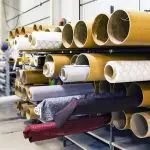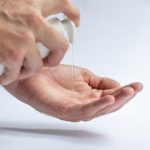Looking to mend fabric with precision and strength? Wondering if Loctite Cyanoacrylate glue is up to the task?
Let's explore its potential for holding fabric together.
Key Takeaways
- Cyanoacrylate glue forms a strong bond with fabric due to its rapid curing and strong adhesion properties.
- Fabric compatibility with cyanoacrylate glue is crucial for successful bonding.
- Different fabrics have varying porosity and absorbency, which can affect how well the glue bonds.
- Proper application techniques, such as cleaning and preparing the fabric, are important for achieving a strong and long-lasting bond.
Understanding Cyanoacrylate Glue
When working with fabric, you can rely on Loctite Cyanoacrylate Glue to form a strong bond due to its rapid curing and strong adhesion properties. Understanding the adhesion properties of this glue is crucial for successful fabric bonding.
Cyanoacrylate glue works by creating a rapid chemical reaction when it comes into contact with moisture, such as the humidity in the air or the slight moisture present in the fabric. This reaction causes the glue to cure quickly, forming a strong bond with the fabric.
In addition to understanding the adhesion properties of the glue, proper fabric preparation techniques are essential for achieving the best results. Before applying the cyanoacrylate glue, it's important to ensure that the fabric is clean and free from any dust, dirt, or oils that could hinder adhesion. Some fabrics may benefit from roughening the surface slightly to improve the bond.
Fabric Compatibility
To determine if Loctite Cyanoacrylate Glue can effectively bond with fabric, consider the fabric's compatibility with the adhesive. Fabric compatibility plays a crucial role in the success of fabric bonding techniques using cyanoacrylate adhesives. When selecting a fabric adhesive, it's essential to choose one that's compatible with the specific type of fabric you're working with.
Different fabrics have varying compositions and textures, which can affect how well the adhesive bonds to the material. When assessing fabric compatibility, it's important to consider the porosity and absorbency of the fabric. Some fabrics, such as cotton and wool, are more porous and absorbent, while others like polyester and nylon have a smoother, less absorbent surface. The porosity of the fabric can impact the adhesive's ability to form a strong bond.
Additionally, the flexibility and stretchiness of the fabric should be taken into account, as these factors can affect the durability of the bond over time. Understanding the compatibility of Loctite Cyanoacrylate Glue with different types of fabric is essential for achieving successful fabric bonding.
Application Techniques
You can apply Loctite Cyanoacrylate Glue to fabric using the dabbing method for optimal adhesion.
First, ensure the fabric is clean and dry. Apply a small amount of the glue to one of the fabric surfaces.
Then, gently press the two fabric pieces together. The dabbing method helps to distribute the glue evenly and prevents excess glue that can seep through the fabric.
After pressing the fabric pieces together, hold them firmly for about 30 seconds to ensure a strong bond. Applying pressure during this time is crucial for the glue to effectively adhere to the fabric.
Once the pieces are joined, allow the glue to dry completely. The drying time can vary based on factors such as the amount of glue used and the type of fabric. Typically, it takes around 10-30 minutes for the glue to set, but for a full cure, it's best to leave the fabric undisturbed for 24 hours.
Following these application techniques will help you achieve a durable and reliable bond between fabric pieces using Loctite Cyanoacrylate Glue.
Bond Strength Testing
After applying Loctite Cyanoacrylate Glue to fabric using the dabbing method, you can evaluate the bond strength by conducting a pull or shear test. This test involves applying force to the fabric pieces to assess the integrity of the bond.
Pull testing involves exerting force in opposite directions, perpendicular to the bond line, to determine the maximum force the bond can withstand before breaking.
Shear testing, on the other hand, applies force parallel to the bond line to assess the bond's resistance to sliding forces.
To perform a pull test, secure one fabric piece in a stable position and attach the other to a force gauge. Gradually apply force until the bond breaks, and record the maximum force.
For shear testing, affix one fabric piece to a stable surface and apply force parallel to the bond line to measure the bond's resistance to sliding.
Adhesion testing can also be conducted using a peel test, where force is applied parallel to the bond line to peel the fabrics apart.
Considerations for Different Fabrics
When using Loctite Cyanoacrylate glue on fabric, it's important to consider the type of fabric you're working with. Different fabrics have different properties, so it's essential to take into account factors like fabric weight and texture.
Before applying the glue to a larger area, always test it on a small, inconspicuous area of the fabric to ensure compatibility and a strong bond.
Fabric Type Matters
Using a cyanoacrylate glue like Loctite for fabric bonding depends on the type of fabric you're working with. Consider the following when choosing the right fabric for your project:
- Fabric Composition: Different fabrics, such as cotton, polyester, silk, or wool, have varying levels of absorbency and flexibility. Some fabrics may not bond well with cyanoacrylate glue due to their composition, while others may adhere strongly.
- Sewing Techniques: Fabrics that have been serged, hemmed, or have frayed edges may require different bonding methods than fabrics with clean, straight edges. Consider how the fabric has been treated and sewn when deciding on the appropriate bonding method.
- Fabric Thickness: Thicker fabrics like denim or canvas may require a stronger adhesive bond than thinner fabrics like chiffon or organza.
- Fabric Stretch: Fabrics with stretch, like spandex or elastane, may require a flexible adhesive that can accommodate movement without cracking or breaking.
Consider Fabric Weight
Consider the fabric weight when choosing the appropriate bonding method for different fabrics. Fabric thickness and material composition play a crucial role in determining the most effective adhesive for joining fabrics. Here's a breakdown of how fabric weight influences the choice of bonding method:
| Fabric Type | Bonding Method |
|---|---|
| Lightweight | Cyanocrylate glue |
| Medium Weight | Fabric glue |
| Heavyweight | Sewing or hemming |
| Stretchy Fabric | Fabric glue or fusible interfacing |
Test on Small Area
Before applying the glue to a larger area, you should first test it on a small, inconspicuous section of the fabric to ensure compatibility. Here are some considerations for different fabrics:
- Fabric Flexibility: Some fabrics are more flexible than others. Test the glue on a small area to ensure that it can withstand the fabric's movements without cracking or becoming brittle.
- Glue Penetration: Different fabrics have varying densities and textures. Testing the glue will help you determine if it can penetrate the fabric effectively without leaving a visible residue on the surface.
- Color Fastness: The glue may affect the color of the fabric. Testing it on a small area allows you to assess any potential color changes before applying it to a larger area.
- Washability: Check how the glued fabric holds up after being washed. This will help you determine the longevity of the bond without causing damage to the fabric.
Durability and Longevity
When using Loctite Cyanoacrylate Glue to bond fabric, ensuring proper application and allowing sufficient curing time is essential for achieving maximum durability and longevity. The adhesive properties of Loctite Cyanoacrylate Glue make it a strong choice for fabric bonding, but it's crucial to subject the bond to durability testing to ensure it meets the specific requirements of your project.
This can involve testing the bonded fabric under various stress conditions to evaluate its resilience over time. Additionally, consider factors such as exposure to moisture, temperature fluctuations, and general wear and tear that the fabric may encounter in its intended use. By conducting thorough durability testing, you can gain confidence in the long-term strength and resilience of the fabric bond.
It's important to follow the manufacturer's recommendations for curing time and any additional steps that may enhance the durability of the bond. By doing so, you can maximize the longevity of the fabric bond and ensure that it meets your performance expectations.
Alternative Fabric Repair Options
Looking for alternative ways to repair fabric?
Consider sewing as a reliable and durable option, especially for tears and holes.
Iron-on patches can also be a quick and easy fix for small damages,
while fabric glue provides a convenient solution for seamless repairs.
Sewing as Repair
You can repair fabric by sewing it together with a needle and thread. When using hand sewing as a repair option, consider the following:
- Fabric Selection: Choose a thread that matches the fabric's color and weight to ensure a seamless repair. For heavier fabrics, such as denim or canvas, opt for a thicker, more durable thread.
- Needle Choice: Use the appropriate needle for the fabric type. Sharp needles work well with tightly woven fabrics, while ballpoint needles are better for knits and stretch fabrics.
- Stitch Technique: Employ sturdy stitching techniques like the backstitch or the slip stitch for a strong and nearly invisible repair.
- Reinforcement: For added durability, reinforce the repaired area by applying a small, discreet patch on the backside of the fabric.
Iron-On Patches
To repair fabric using iron-on patches, follow these steps:
- Select a patch that matches the fabric's color and weight.
- Read and follow the manufacturer's instructions for applying the patch securely to the damaged area.
- Ensure that the patch placement covers the entire damaged area and overlaps the surrounding fabric slightly.
- Preheat an iron to the temperature recommended by the patch manufacturer.
- Place a thin cloth over the damaged area to protect it.
- Position the patch on the fabric.
- Press the iron firmly over the patch for the specified duration.
- Allow the fabric to cool before testing the patch's adhesion.
Iron-on patches provide a convenient and durable alternative to sewing. They effectively restore the functionality and aesthetic appeal of damaged fabric.
Fabric Glue Options
When considering alternative fabric repair options, such as fabric glue, it's essential to weigh the benefits and limitations of this adhesive method in comparison to iron-on patches. Here are some factors to consider:
- Adhesive strength: Fabric glue provides a strong bond, but it may not be as durable as iron-on patches for heavy-duty repairs.
- Fabric flexibility: Fabric glue allows for natural movement and flexibility of the fabric, making it suitable for repairing areas that need to stretch or move.
- Application ease: Fabric glue offers a quick and easy application process, making it convenient for small, intricate repairs.
- Washability: Some fabric glues are machine washable, providing a reliable and long-lasting repair solution for clothing items.
Consider these factors to determine whether fabric glue is the right choice for your fabric repair needs.
Tips for Successful Fabric Repairs
For successful fabric repairs, it's important to carefully assess the type of fabric and the extent of the damage before starting the repair process. Different fabrics require different approaches, and understanding the nature of the damage will help you choose the most effective repair method. Here are some essential tips for successful fabric repairs:
| Fabric Preparation | Quick Fixes | Professional Assistance |
|---|---|---|
| – Clean the fabric thoroughly before attempting any repairs. | – Use iron-on patches for quick and temporary fixes. | – Seek help from a professional tailor or seamstress for extensive damage. |
| – Match the thread and fabric type for seamless repairs. | – Apply fabric glue for small rips and tears. | – Consult a fabric restoration specialist for delicate or valuable fabrics. |
| – Use the appropriate sewing machine needle for the fabric. | – Employ fabric tape for hemming and temporary fixes. | – Consider consulting a professional for vintage or antique fabrics. |
Frequently Asked Questions
Can Loctite Cyanoacrylate Glue Be Used to Repair Delicate Fabrics Like Silk or Lace?
Yes, Loctite Cyanoacrylate glue can repair delicate fabrics like silk or lace. Its strong bond provides longevity, but be cautious with stretchy fabrics. It's safe for washing and dry cleaning, ensuring your delicate fabrics stay intact.
Is It Safe to Use Loctite Cyanoacrylate Glue on Fabrics That Will Be Exposed to Frequent Washing or Dry Cleaning?
For frequent washing, Loctite Cyanoacrylate glue may not hold fabric together effectively. Its durability can be compromised, and it may not withstand the rigors of regular washing. Dry cleaning could also affect its effectiveness.
Can the Bond Created by Loctite Cyanoacrylate Glue Withstand High Levels of Stress or Tension, Such as in a Seam or Hem?
Loctite Cyanoacrylate glue can provide strong tensile strength and durable bonding on fabric. It's crucial to consider fabric flexibility and use proper application techniques for optimal results, ensuring a reliable hold under high stress.
Are There Any Special Considerations or Techniques for Using Loctite Cyanoacrylate Glue on Stretchy or Elastic Fabrics?
When working with stretchy fabrics, consider adhesive compatibility for optimal results. Ensure glue application accounts for fabric flexibility. Loctite Cyanoacrylate glue can be effective on stretchy fabrics with proper technique and care.
How Long Does Loctite Cyanoacrylate Glue Typically Last When Used to Repair Fabric?
Loctite Cyanoacrylate glue is highly effective for fabric repairs. It provides strong adhesion and durability, making it a reliable choice. When used properly, it can last for a long time, ensuring a secure and lasting fabric repair.
- Is Corduroy Toxic? Understanding the Fabric’s Safety for You - July 4, 2025
- Is Corduroy for Summer or Winter? Fabric Insights and Tips - July 4, 2025
- Can You Wear Corduroy in Summer? Tips for Stylish Warm Weather Fashion - July 4, 2025







